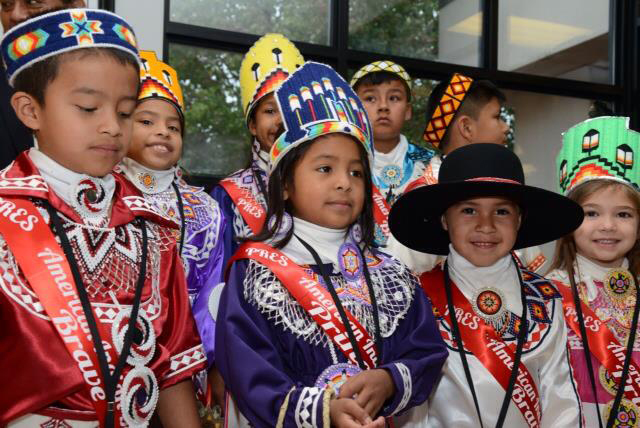
Youth from the Mississippi Band of Choctaw Indians. Photo by Tami Heilemann / Department of the Interior
PBS Newshour interviews Interior Secretary Sally Jewell on the challenges facing Indian youth who attend Bureau of Indian Education schools:
JUDY WOODRUFF: So, we know the problems in the Native American community, they’re deeply entrenched. They go back a long time, to the very beginning of this country. What are just a couple of the ways the administration thinks it can make a real difference? SALLY JEWELL: Well, the report that the White House just issued on Native American youth does a very good job of chronicling the challenges. And they are deep-seated. They have been around for, not just decades, but literally hundreds of years, policies that tried to kill the Indian to save the man, policies of assimilation, of squishing cultures. And, in so doing, they really diminished the confidence and the pride of Native Americans. What the president has done — and he’s charged his Cabinet with this — and this was really powerfully brought home to him in a visit with young people at the Standing Rock Sioux Tribe — is that he doesn’t want to stand by and let this happen anymore. So, he’s charged his administration very directly with being part of the solution, with charting a different course. And that’s what we’re doing. JUDY WOODRUFF: And the challenges, we know because of all the attention on it today, facing young Native Americans particularly tough. I was reading that more than a third of them live in poverty. The statistics, we just reported them, are really discouraging. First of all, how did it get so bad after all this time? And, again, how can the administration make a real difference this time? SALLY JEWELL: Well, the short answer is, there have been reports that have gone back for decades. There was a major report under President Kennedy’s leadership on Indian education that showed many of the same problems. And the difference today, and the difference that we believe strongly in, is around turning over control of these schools to tribal leadership and giving them the tools they need to figure out where are the bright spots, what’s going well and why, so that we can help them bring those lessons to their schools, and yet they have accountability.Get the Story:
Can the U.S. restructure schools to nurture Native American students? (PBS Newshour 12/3) White House Report:
2014 Native Youth Report (December 2014) Government Accountability Office Report:
Bureau of Indian Education Needs to Improve Oversight of School Spending (November 13, 2014)
Join the Conversation
Related Stories:President Obama makes Native youth a priority in administration (12/4)
VOA: Standing Rock Sioux Tribe focuses on education for youth (12/02)
Editorial: Indian schools deserve more federal and state funds (12/01)
Rishawn Biddle: Report confirms how BIE fails Indian children (11/18)
GAO report questions spending at Bureau of Indian Education (11/14)
HuffPo: Carri Jones and Chase Iron Eyes on Indian education (11/7)
Aging BIA school on Navajo Nation awaits replacement funds (10/22)
Jon Whirlwind Horse: New schools bring hope for Indian children (10/02)
Michael Gross: A new battle for self-determination at BIE schools (09/08)
Gerald Gipp: National strategy needed to reform Indian education (08/27)
Sandra Fox: Fixing the education system for our Indian children (08/20)
Secretary Jewell to visit Indian schools in Maine and Minnesota (08/15)
Charles Roessel: BIE reform plan includes teacher certification (07/28)
Carla Mann: Johnson O'Malley needs an accurate student count (07/16)
Reform plan urges billions for Bureau of Indian Education schools (07/09)
Blog: Questions about Bureau of Indian Education reform plans (06/27)
Secretary Jewell announces Bureau of Indian Education reform (06/16
